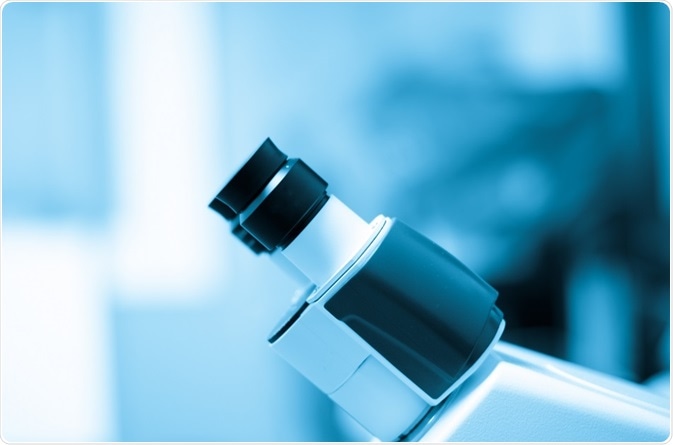Two-photon microscopy is a method that enables the imaging of live cell and tissue samples with high resolution. It is a form of fluorescence microscopy and provides visualization of fluorescent signals via an excitation wavelength being absorbed by a fluorophore and an emission wavelength released.

Credit: Pan Xunbin/ Shutterstock.com
Two-photon microscopy differs from conventional fluorescence microscopy by necessitating two photons to be absorbed by the fluorophore simultaneously, as well as through the excitation wavelengths of the two photons that are longer than the resulting emitted light.
The basic principles of two-photon absorption have been applied to form a technique with unique advantages for imaging in vivo samples. Since its development in 1990, two-photon microscopy has been utilized in various scientific fields such as physiology, neurobiology and embryology.
Advantages gained by applications utilizing two-photon microscopy
Two-photon microscopy applications exploit the advantages of the technology. These advantages include:
- Reduced photobleaching and phototoxicity. Photodamage is a main disadvantage of conventional fluorescence microscopy and hampers its use in imaging live cells and tissues. Photobleaching and phototoxicity cause damage to the cell, reducing its viability especially over long imaging times. Two-photon microscopy reduces photodamage since there is no absorption or fluorescence beyond the plane of focus.
- Increased imaging depth. This is caused by the reduced scatter of the excitation and emission photons. The infrared excitation light in two photon microscopy generally scatters less than the blue/green excitation light in conventional fluorescence microscopy.
- The high resolution imaging of thick tissues. This includes brain slices and whole organs. For conventional fluorescence microscopy, the level of fluorescence decreases at increasing image depths. For two-photon microscopy the fluorescence remains stable with increasing image depth.
The application of two-proton microscopy for imaging UV-excitable fluorophores
While there are few advantages to two-photon microscopy for imaging thin samples in comparison to other three dimensional imaging techniques, the method is preferable for imaging thin samples containing UV-excitable fluorophores. The infrared excitation light used in two-photon microscopy is less harmful to biological samples with UV-excitable fluorophores when compared to methods utilizing UV light.
An example of this application can be found in studies of cellular metabolism where the autofluorescence of the coenzyme NADH is imaged. The amount of autofluorescent NADH increases during glycolysis and citric acid cycle metabolism. Two-photon microscopy has allowed for a greater understanding of these processes within living cells.
The application of two-proton microscopy for deep tissue imaging
The advantages of two-photon microscopy mean that imaging depths exceeding 1 millimeter can be achieved. Therefore, imaging of tissue and whole organ preparations from small animals can be produced.
One example is the procedure for performing two-photon in vivo imaging on the dorsal surface of mice brains. A study described the procedure and the resulting high resolution images of fluorescently labelled neurons with little damage to cells or tissue. The method has since been applied to various aspects of neuronal activity – including imaging electrical impulses, neuronal architecture and blood flow within the brain.
A further deep tissue imaging application of two-photon microscopy is for the study of immune cell dynamics. Lymphocytes have long been examined away from their normal environment, increasing the knowledge of how such cells respond to different stimuli.
Two-photon microscopy has enabled deeper understanding of lymphocyte biology through its utilization in studies of the cell within its normal environment. Real-time imaging has been produced of immune cell migration and the interaction of immune cells with other cells in vivo.
The application of two-proton microscopy for imaging embryos
An early application of two-proton microscopy was for imaging mammalian embryo development. Because photobleaching and phototoxicity is reduced in two-proton microscopy, the technology was considered superior for maintaining embryo viability. This was tested with mitochondrial staining of mammalian embryos imaged in a twenty-four hour time frame.
The two-photon microscopy technique reduced photodamage, meaning the embryos were viable after imaging and produced healthy full term organisms once implanted. The conventional imaging techniques that were compared did not produce viable embryos after imaging.
Technological advancements evidenced in more recent applications of two-proton microscopy have led to the faster imaging of embryos, including those of fruit flies and zebra fish, while at the same time maintaining viability.
Further Reading
Last Updated: May 27, 2019